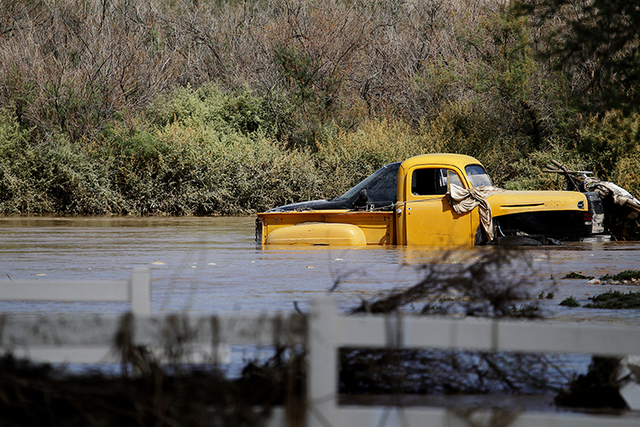Driving tip for floods: Turn around, don’t drown

If you don’t have respect for Mother Nature and her flash-flooding wrath after last week, you probably don’t belong on the road when it rains.
Of course, many motorists don’t belong there, anyway, because they fail to understand that a light coating of rain atop an oil-touched stretch of pavement will turn a highway into a surface as slippery as black ice.
Last week, it wasn’t light rain that was of concern. It was the volume of H2O delivered in a classic 100-year desert flash flood.
A scenario that played out on Interstate 15 north of Las Vegas was the theme of several emails that “flooded” the Road Warrior in box.
“Turn around, don’t drown” is the mantra of the National Weather Service when flash floods are imminent.
So what happens when you see that torrent of water ahead of you and you’re on an interstate highway? Should you still turn around, even though the traffic is one way opposite your direction?
I asked that of Erin Neff, public information manager of the Clark County Regional Flood Control District.
Her response: Yes, if it’s a life-threatening event, use whatever means you can to get out of there.
“You’re going to have to assume that traffic ahead of you is going to slow down, probably come to a stop,” she said. “Heed the warnings, assess the situation and use common sense.”
A quick plug for the district — “heed the warnings” means now might be a good time to download the district’s free app, Flood Spot, which pushes flash flood information to your smartphone.
“We dodged some serious bullets in this flood because no one died,” Neff said.
But there were some close calls. A number of motorists had to be rescued from their stranded vehicles when the flood came.
Another common question was how deep is too deep? How high must the water be to retreat?
Neff said a good rule of thumb is that you reverse course when the water level is 1 foot deep. If floodwater covers your tires, you’re in trouble.
Unless you own one of those James Bond amphibious vehicles, your engine is going to stall out when floodwater gets in under the hood.
Another problem is that floodwater is usually muddy and you won’t be able to see what’s on the roadbed.
There could be rocks, tree limbs or other debris that could wreck your axle.
The rushing water could move the car. There were videos from last week’s storm showing cars pushed over surprise desert waterfalls. It doesn’t have to happen.
“Last week, there was nothing that could be done to prevent some of the flooding that occurred,” Neff said. “It’s like planning for an earthquake. You can reinforce the roads and bridges, but if it’s big enough, it’s still going to knock them down. The best thing you can do is to be vigilant and pay attention.”
ON CAMERA
Warrior reader Dave has a question about those cameras mounted near the traffic signals:
I’ve noticed many red-light cameras mounted all throughout Henderson. Are these operational or are they testing them? I thought the Nevada Legislature deemed them unacceptable for ticketing purposes.
The city of Henderson has no red-light cameras for ticketing purposes, city spokesman Keith Paul said.
“The cameras that motorists see on city of Henderson signal poles are only used to detect if a vehicle is stopped at a signal,” he said.
“The detection cameras are mounted toward the travel lanes and communicate with the signal controller — the box that is at every intersection — to help control the signal by detecting when there is and is not stopped traffic at the signal. The cameras do not have recording capabilities.”
PRIVATE STREETS
Prolific Dave had another question about those private streets west of Green Valley Ranch.
The roads just to the west of the Green Valley Ranch have long sported signs saying “private street,” when in fact there is complete public access throughout. Could this have to do with maintenance and not with traffic? I asked a police officer out there about it a long time ago, and he had no idea either.
The private streets west of the Green Valley Ranch Resort are owned and maintained by the resort, Paul explained.
“Private streets are required to post brown street name signs, rather than the usual green street name signs,” he said.
“This allows city workers and other municipalities to easily identify the private streets.”
Commonly, private roads are gated. However, when private roads are not gated, as in this case, the property owner allows the public to utilize the road, he said.
Questions and comments should be sent to roadwarrior@reviewjournal.com. Please include your phone number. Follow the Road Warrior on Twitter @RJroadwarrior.